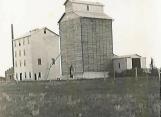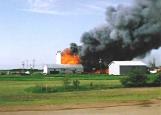2
The Sterling Flour Mill, built in 1911-1912, was one of the oldest large capacity flour mills in Alberta, its machinery representing the best in milling technology at the time.4
There were many reasons for building the flour mill in Strome; one of these reasons being the location. In Strome, the mill was close to Forestburg, where coal could have been purchased to run the steam engines. The mill in Strome was also the only one in the area, the nearest mills being Wetaskiwin to the west, Saskatoon to the east, Stettler to the south and Vermillion to the north. These factors, along with the fertility of the land in the Battle River watershed made Strome the obvious location for another flour mill.The Strome Milling Company was composed of local residents who thought that a mill would be a profitable enterprise for Strome. On October 23, 1911, the Strome Milling and Grain Company registered with the Alberta government and submitted the prospects of the Strome Milling and Grain Company which outlined the intentions of the board. According to the calculations in the prospects the mill stood to make $69,000.00 profit a year running at full capacity, $33,000.00 per year running at half capacity. What the directors failed to realize was that the hard economic truths of the milling industry would seriously impair the commercial feasibility of such and endeavor in Strome.
On first look the market for flour produced was very good with potential markets in British Columbia and as far away as China and Japan. Apart from selling flour, they were confident that money could be made from custom grinding of wheat, oats and barley for the local farmers. A survey was done in the area to see if there would be enough wheat produced to support the mill and to find out if local residents would be interested as investors; and the response was positive on both accounts.
To raise the money required to build the mill, $50,000.00, 1,000 shares were printed to be sold at $50.00 each. On July 23, 1912, the Sterling Flour Mill opened ready to produce 200 barrels of "Fancy Patent Flour" a day. In 1914, a storage warehouse was built, completing the flour mill. Until July 13, 1997, the mill stood the same.
5
Taken from the Edmonton Journal, May 5, 1934Size doesn't always count. The village of Strome has probably less than 250 population. The district of which it is the centre is not a particularly large one. And this village has two larger neighbors only 10 miles away, Killam on one side and Daysland on the other. Yet, Strome carries on remarkably well. There is evidence of vitality and optimisim on the part of the citizens.
Strome's determination to be something and to do something is seen in its really fine stores, good hotel, garage and other places of business which make it worth while for people to visit and trade at this centre.
Apart from these there is in particular an industry here which brings many to Strome in the courseof a year and has carried the name of this village to many distant points of the province. This is the Strome Flour Mills, one of the most outstandingly successful mills in the west and reputed to be the best equipped privately owned mill in the three provinces.
It was built in 1911 and carried on extensive operations for a number of years, being especially active during the war period when its output of flour was very large. What happened after that is immaterial to the present narrative. Suffice to state that the property and business was acquired early in the year 1931 by the present proprietor, M.J. McCuaig, under whose management the business has been doubled each year.
The mill is a large four-storey building and in connection with it are a 50,000 bushel grain elevator and large flour warehouse. From top to bottom the Strome Flour Mills is a model establishment, provided with the most complete and modern equipment of every kind. It has a six double-stand long system mill, capable of turning out the most superior quality of flour and has an output capacity of 200 barrels a day. Directly in charge of milling operations is J.C. Johnstone, one of the leading millers of the west, with a lifetime's experience in the business.
Another factor of great importance in the success of this enterprise is the quality of wheat produced in this part of the country. In the area from Daysland to Hardisty and south to the Battle River, the wheat produced – notably the Marquis – is of exceptional quality carrying from 13 to 14 percent of protein content and much of it is of the top grades. It is the very best of milling wheat and yields the finest of flour, both as to color and grain.
This flour, the Sterling brand, enjoys a wide market that extends all the way from the far points of the Peace River country, over central and northern Alberta and into Saskatchewan. To serve their large demand in Edmonton the firm has a warehouse there.
7
Unfortunately, the mill was never able to make as much profit as was assumed in the prospects. This loss of profits caused the mill to change hands many times and by 1930 it was in the stage of disrepair. In 1931, M.J. McCuaig owned the mill for ten years; managing to turn enough profits to keep the mill in good running condition. This is very commendable as this was accomplished during the Great Depression. With the advent of World War II, Mr. Quaig was asked to run the mill continuously to supply flour as many European mills were being destroyed. Mr. McCuaig did not wish to run the flour mill, so he sold it to two men from Okotoks, Alberta. From 1942 to 1953, it is estimated that the mill produced 150 million pounds of flour. During this time period, the mill was converted from coal to electricity.After 1953, the great demand for flour tapered off and again the mill slowed down. The doors to the mill finally closed in 1958 except for occasional orders to local bakers up until 1967. The owners eventually went into the full time business of mixing and grinding feeds for livestock, along with selling veterinary supplies. Eventually the Blaeser brothers, Ed and Ray of Strome and Killam purchased the mill and changed its name to Strome Feed Services.
Prior to burning down in on July 13, 1997, the Strome Feed Mill was owned and operated by Brian Steiger of Strome.


